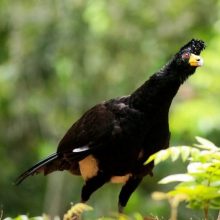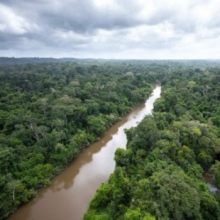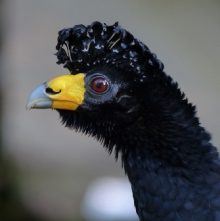How habitat modelling can help in management of a vulnerable bird species
LINKED PAPER
Black Curassow habitat relationships in terra firme forests of the Guiana Shield: A multiscale approach. 2016. Denis T, Hérault B., Jaouen G., Brunaux O., Guitet S. & Richard-Hansen C. The Condor : ornithological applications. DOI: 10.1650/CONDOR-15-28.1 VIEW
The French Guianan human population is showing a strong demographic expansion that is likely to intensify anthropogenic pressure in the coastal strip, and risks impacting wildlife habitats and animal populations in the future. It is important to study and improve scientific knowledge on medium and large-sized vertebrates in order for more effective practices to be implemented in conservation and wildlife management. The Black Currassow (Crax alector) belongs to the Cracids, one of the more threatened bird families in South America.
The Black Currassow is a large game bird (Figure 1) found in north-central South America. This species is known to be associated with undisturbed and unmodified forests, and is highly sensitive to hunting. In French Guiana, most of the forested area is difficult to access and thus remains little affected by human activities. However, with the increase of human population it is expected that the extent of forest impacted by human activities will increase (Rossi et al. 2015). Nonetheless, Black Curassow habitat relationships remain poorly known.

Across the Amazon basin, terra firme forests differ from floodplain forests (so-called Varzea) in faunal composition; specifically the abundance of monkeys and large birds (Haugaasen et al. 2009). The major part of the French Guiana is covered by terra firme forests. Recent studies have highlighted that these forests vary in tree composition as well as stand structure, both under control through geomorphology (Guitet et al. 2015a et b). Medium and large-sized vertebrates also vary in composition and diversity in relation to the different geomorphological landscapes (Figures 2 and 3) (Richard-Hansen et al. 2015).
To identify the habitat associations of Black Curassow, we carried out surveys along line transects (Peres et al. 1999) in 35 study sites located in the terra firme forests ensuring that the different landscape types across French Guiana were represented: coastal plain; plateau; mountain (all-slope landscape); multiconvex, e.g., dome form; and multiconcave, e.g., basin form (Guitet et al. 2015). From remote sensing descriptors, we developed a predictive map of Black Curassow distribution based on habitat species modelling. Areas that were near inhabited areas and access paths (within 2.5km) were considered as hunted (Figure 4).


In our study, we found that both the mean slope of landforms (remote sensing data) and the presence of hunting in the area had significant effects on Black Curassow density. The density increased with the increase of mean slope whatever the hunting pressure (absence or presence). Density varied from 0.4 to 1.1 adult individuals per square kilometer in hunted areas while it varied from 1.5 to 5.3 in unhunted areas. The predictive map (Figure 4) showed that coastal plain, areas close to main rivers and human settlements, and two patches in the southern part of the territory (located in multiconcave reliefs) had lower density. In contrast, density was the highest in mountainous forested areas in the southwestern and central eastern parts, where slope was the steepest and farthest away from inhabited areas and access paths.
 Figure 4 Predictive map of the distribution of adult-sized Black Curassow (individuals per square kilometre) in French Guianan terra firme rainforests according to the landscape-scale model. The areas in gray on the map to the bottom right (2.5-km-wide buffer along the main rivers and roads and around human settlements) were considered to be hunted. See details in the linked paper.
Figure 4 Predictive map of the distribution of adult-sized Black Curassow (individuals per square kilometre) in French Guianan terra firme rainforests according to the landscape-scale model. The areas in gray on the map to the bottom right (2.5-km-wide buffer along the main rivers and roads and around human settlements) were considered to be hunted. See details in the linked paper.
Apart from the influence of hunting, there is an important heterogeneity of population density that relates to environmental conditions. The steepest areas are probably those that better correspond to the ecological requirements of the species. Topography doesn’t directly influence species presence, but it is a good proxy of actual environmental conditions, and also of the forests’ ecological history. (Guitet et al. 2013; Guitet et al. 2015a). Many studies underlined the influence of topography (through soil drainage for example) on forest structure and tree composition (Ferry and Morneau 2010), which potentially have a more direct effect on animals.
Hunting is the most important factor that explains Black Curassow distribution, which confirms the species’ vulnerability to this human activity, a result already found for other cracids (Kattan et al. 2016). Even in optimal habitat areas, predicted density is very low when hunting occurs. This species is a very popular game bird because of its tasty meat, large body size and noisy behavior, which make it easy to find and hunt. A preliminary study has already suggested that Black Curassow hunting is unsustainable in areas close to human settlements (Niel et al. 2008). However, low Black Curassow density is not always an indication of overhunting, since low density can also occur without any human disturbance, in flattest reliefs.
Our predictive map of Black Curassow distribution has several implications in terms of conservation and hunting management strategy. The mapping results highlight the need to maintain connectivity between Black Curassow populations across French Guianan forests. Furthermore, the improved estimate of population size allows more accurate determination of its conservation status and to possibly set up hunting quotas according to habitat quality.
To date, the conservation status of Black Curassow is generally good in French Guiana, but its status in future will depend on the spatial extension of human activities, and also on the policy decisions made in terms of game management.
References
de Thoisy, B., Richard-Hansen, C., Goguillon, B., Joubert, P., Obstancias, J., Winterton, P. and Brosse, S. 2010. Rapid evaluation of threats to biodiversity: Human footprint score and large vertebrate species responses in French Guiana. Biodiversity and Conservation 19: 1567-1584. VIEW
Ferry, B., and Morneau F. 2010. Higher treefall rates on slopes and waterlogged soils result in lower stand biomass and productivity in a tropical rain forest. Journal of Ecology 98: 106-116. VIEW
Guitet, S., Cornu, J.-F., Brunaux, O., Betbeder, J., Carozza, J.-M. and Richard-Hansen, C. 2013. Landform and landscape mapping, French Guiana (South America). Journal of Maps 9: 325-335. VIEW
Guitet, S., Pélissier, R., Brunaux, O., Jaouen, G. and Sabatier, D. 2015a. Geomorphological landscape features explain floristic patterns in French Guiana rainforest. Biodiversity and Conservation 24: 1215-1237. VIEW
Guitet, S., Brunaux, O., de Granville, J.-J., Gonzalez, S. and Richard-Hansen, C. 2015b. Catalogue des habitats forestiers de Guyane. DEAL Guyane. 120 p. VIEW
Haugaasen, T. and Peres, C.A. 2009. Interspecific primate associations in Amazonian flooded and unflooded forests. Primates 50: 239-251. VIEW
Kattan, G. H., M. C. Muñoz, and Kikuchi D. W. 2016. Population densities of curassows, guans, and chachalacas (Cracidae): Effects of body size, habitat, season, and hunting. The Condor: Ornithological Applications 118:24–32. VIEW
Niel, C., Richard-Hansen, C. and Debeir, L. 2008. L’incertitude dans l’estimation de durabilité de la chasse : le cas du hocco en Guyane. Rapport scientifique ONCFS 2007 : 25-31. VIEW
Peres, C.A. 1999. General guidelines for standardizing line-transect surveys of tropical forest primates. Neotropical Primates 7: 11-16. VIEW
Richard-Hansen, C., Jaouen, G., Brunaux, O., Denis, T. and Guitet, S. 2015. Landscape patterns influence communities of medium- to large-bodied vertebrates in undisturbed terra firme forests of French Guiana. Journal of Tropical Ecology 31: 423-436. VIEW
Rossi, V., Dolley, T., Cornu, G., Guitet, S. and Hérault, B. 2015. GuyaSim: un outil d’aide à la décision pour l’aménagement d’un territoire forestier, la Guyane. Bois et Forêts des Tropiques 326 (4) : 67-78. VIEW
Image credit
Featured image: Black Curassow (Crax alector) © Mathias Fernandez
If you want to write about your research in #theBOUblog, then please see here.





